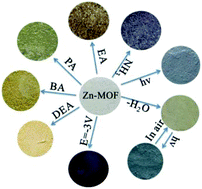A novel viologen-based coordination polymer with multi-stimuli responsive chromic properties: photochromism, thermochromism, chemochromism and electrochromism†
Abstract
Increasing interest in chromic materials is due to the growing demand. However, most chromic materials exhibit color changes in response to only one stimulus, but there are multiple stimuli in nature. Therefore, the construction of multistimuli responsive chromic materials still faces great challenges. Herein, a new multi-stimuli responsive coordination polymer [Zn2(2,3-PDC)2CV·(H2O)2]·H2O (1) (2,3-PDC = 2,3-pyridine dicarboxylic acid, CV = N,N′-4,4′-bipyridiniodipropionate) has been successfully synthesized, which exhibits photochromism under 300 W xenon lamp irradiation accompanied by an obvious color change from colorless to light blue. Meanwhile, compound 1 displays excellent thermochromic properties with a color change from colorless to light yellow when heated at 106 °C. The product of thermochromism is named 1T and the loss of free water improves the photoresponsive properties of 1T. Moreover, the compound can show differentiable detection of amines because of the electron-deficient nature of the viologen. Finally, 1 shows excellent electrochromic properties and turns from colorless to purple at E = −3 V. In conclusion, compound 1 exhibits multi-chromic behaviors in response to light, heat, amines and electricity, which are prominent in viologen based coordination polymers.



 Please wait while we load your content...
Please wait while we load your content...